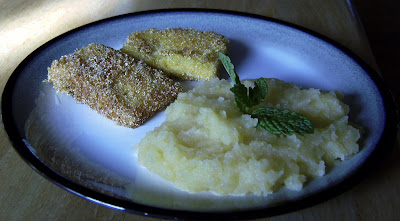
Yeah, that's right, chocolate. Your kitchen will smell DeLiCiOuS. Resist the urge to use whatever chocolate bar you have lying around--you need unsweetened baking chocolate because this is a savory chocolate showcase, like
mole, and a handful of Hershey's kisses will just taste weird.
If you're new to
chipotles, they can usually be found, dried, in the international section of your supermarket or a Latin American grocery store (where they'll be WAY cheaper). They have a great smoky flavor and cooking them whole in the soup allows you to control the final level of heat--at the end, you can puree the whole chile, half or none and return it to the soup, depending on your spice tolerance.
Get to the Chocolate Already.1 cup dried black beans
1 dried chipotle chile
2 tablespoons olive oil
½ teaspoon cumin
½ an onion, minced
2 whole cloves
¼ teaspoon allspice
½ teaspoon cinnamon
5 cups stock
1 ounce unsweetened baking chocolate
3 tablespoons tomato paste
Salt to taste
Optional but Delicious Garnishes1 cup peanut oil
4 shallots, sliced paper-thin
Sour cream
Yeah, Yeah, and When do I Add the Chocolate?Soak beans and chipotle however you normally do dried beans--either cover them with water for 8 hours or do the quick-soak method (cover with water, bring to a boil for five minutes, remove from heat and let sit, covered, for an hour). Drain beans and chipotle.
Heat olive oil in a large soup pot and add cumin and onions. Stir for about 3 minutes, then add remaining spices, stock, chocolate and soaked beans and chile. Bring to a boil, then reduce heat and simmer for an hour to an hour and a half, until beans are tender. Remove about 2 cups of the soup and the chipotle and puree, then return to pot. (If you're not into spiciness, you can just remove the chipotle altogether and just puree 2 cups of soup). Stir in tomato paste until dissolved and add salt to taste (these are added at the end because both salt and tomatoes prevent dried beans from cooking. Retain that for cocktail-party conversation).
Garnish time! Heat peanut oil in a small saucepan, add shallots, and fry 2-3 minutes, until crispy. Drain the shallots into a sieve (save the oil!) or remove them quickly with a slotted spoon onto paper towels. The used oil is great for instant flavor in stir-fries.

Serve the soup with a dollop of sour cream and a sprinkle of crispy shallots.
 This is our favorite rice to serve under dum or mild curries--anything subtly flavored, and especially anything with sweeter vegetables like tomatoes, carrots, sweet potatoes or winter squash. Baking rice in the oven rather than simmering on the stovetop has two key benefits: it frees up burner space for whatever else you're whipping up, and it heats your house so your living room isn't 40 degrees when you're trying to have a dinner party.
This is our favorite rice to serve under dum or mild curries--anything subtly flavored, and especially anything with sweeter vegetables like tomatoes, carrots, sweet potatoes or winter squash. Baking rice in the oven rather than simmering on the stovetop has two key benefits: it frees up burner space for whatever else you're whipping up, and it heats your house so your living room isn't 40 degrees when you're trying to have a dinner party.











